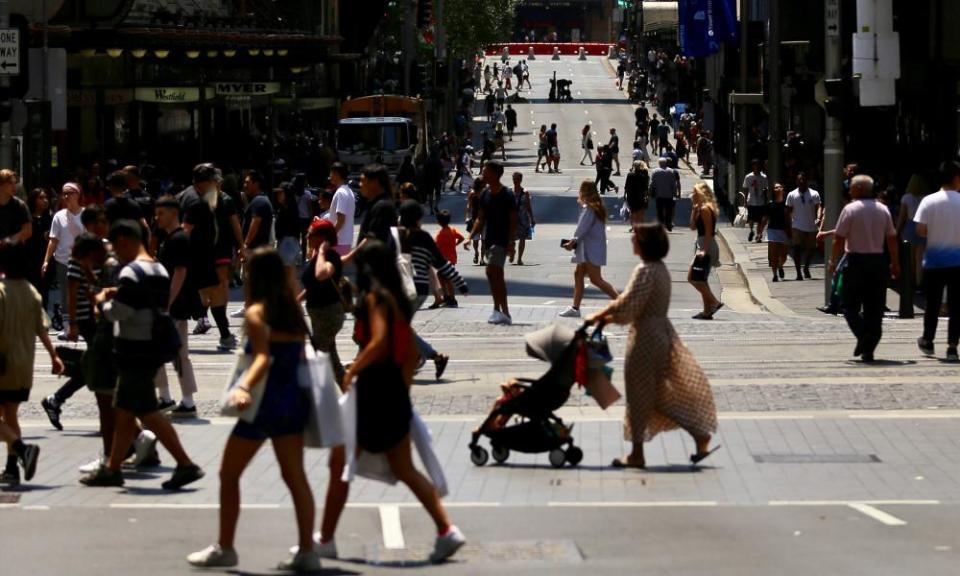Australian economy grew 0.2% in first three months of the year, the slowest since Covid lockdowns

Australia’s economy slowed in the March quarter as households dipped into savings to keep spending amid a record run of interest rate rises and imports rose faster than exports.
The country’s gross domestic product expanded at a quarterly rate of 0.2% in the first three months of the year, and by an annual rate of 2.3%. Economists had expected GDP growth of 0.3% for the quarter and 2.4% for the year.
The quarterly pace of growth was the slowest since the economy contracted in the September quarter of 2021 during widespread Covid lockdowns.
Slipping towards a recession? GDP growth slowed to 0.2% in the March quarter from 0.5% in the December quarter. That's the slowest pace since the economy contracted during the July-September 2021 Covid lockdowns in eastern Australia. pic.twitter.com/i6jti0DO06
— @phannam@mastodon.green (@p_hannam) June 7, 2023
“Higher interest rates and cost-of-living pressures are squeezing household budgets and slowing our economy at the same time,” the treasurer, Jim Chalmers, told a media conference. “These numbers today are unsurprising and consistent with our expectation for a moderation in growth in our economy.”
While the rise in interest rates was “clearly biting”, salaries and wages were on the rise. These expanded 2.4% in the quarter and 10.8% over the year, making it the fastest growth in almost 16 years, he said.
Chalmers said he would not make predictions about whether the June quarter data would show a contraction in the economy.
The national accounts data, released by the Australian Bureau of Statistics on Wednesday, come a day after the Reserve Bank hiked its key interest to 4.1%, the 12th increase in 13 months. Today’s GDP figures provide details of the momentum of the economy at the start of 2023 and may influence future RBA rate decisions.
The initial response from investors was muted, with stocks and the Australian dollar little changed. Comments earlier in the day by the RBA’s governor, Philip Lowe, that the path to a soft landing for the economy was narrow and “likely to be a bumpy one” were largely as expected.
Analysts, though, will probably focus on the weakening generators of growth in the economy. Half of the March quarterly GDP growth came from household spending that itself is increasingly funded by savings.
“Spending on essential goods and services were the main contributors to the rise in household spending, while discretionary categories such as furnishing and household equipment, purchase of vehicles and other goods and services all detracted from growth,” said Katherine Keenan, the ABS’s head of national accounts.
Households’ total income rose 1.7% as wages picked up, but total payables rose 4.4%, with higher interest repayments and the rising cost of living key factors.
To fund the gap, consumers dipped into savings, sending the household saving-to-income ratio down to 3.7%, its lowest level since the June quarter of 2008, the ABS said.
Households are saving less, with the ratio to income down to 3.7% in the March quarter. That's the lowest since the June quarter of 2008, @ABSStats says. pic.twitter.com/xQ7OGcL5dN
— @phannam@mastodon.green (@p_hannam) June 7, 2023
Westpac economists said the savings ratio was now below the roughly 6% so-called equilibrium level for a second straight quarter.
“The period of ‘excess savings’, which was a feature during the pandemic, has ended,” the economists said.
Essential spending was led by electricity, gas and other fuel, up 5.2% for the quarter. Spending on food rose 0.4%.
“Growth in rent and other dwelling services (0.5%) and insurance and other financial services (0.5%) remained stable but emerged among the largest contributors to total expenditure this quarter,” the ABS said.
Another drag on growth came from imports rising 3.2%, outpacing the 1.8% expansion of exports. The resulting drop in net exports cut 0.2 percentage points of GDP growth for the quarter.
Exports rose for a fourth consecutive quarter, with services exports up 7.7% including a 17.5% jump in travel services.
“Travel services exports have now recovered to around 70% of pre-pandemic levels,” Keenan said.
Goods imports rose 3.3%, including gains of 4.9% for consumables and 5.3% for capital equipment. Overseas travel spending rose 7.1%, contributing to a 3.1% rise for service imports overall.
Spending by the private and public sectors both rebounded from drops in the December quarter.
So-called private gross fixed capital formation, which takes in new plant and equipment, gained 1.4%, reversing a 0.9% fall in previous three months. Spending on new and used dwellings, though, fell 1.3%, with outlays on renovations or additions dipping 0.9%, implying higher interest rates were holding back spending on housing.
Government spending on capital rose 3%, reversing a 1.2% drop in the December quarter. Within that total, state and local governments lifted spending 3.9% while non-financial government agencies lifted spending on transport infrastructure and health by 4.1%, the ABS said.

 Yahoo Finance
Yahoo Finance 